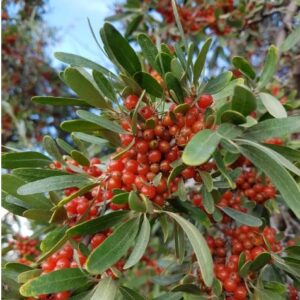Description
The black walnut tree (Juglans nigra) is a remarkable and valuable species native to eastern North America. Known for its strong, durable wood and nutritious nuts, it holds a prominent place in forestry, horticulture, and even historical medicine. Here’s an in-depth look at the black walnut:

1. Botanical Overview of the Black Walnut Tree
- Scientific Name: Juglans nigra
- Family: Juglandaceae
- Growth Zones: Typically hardy in Growing zones 4–9.
- Lifespan: Black walnuts can live over 200 years, making them long-term investments for landowners.
- Height and Spread: Mature trees reach 50-75 feet in height and have a spread of 50-75 feet, creating an open, rounded crown.
2. Physical Characteristics
- Leaves: Pinnately compound leaves consist of 15–23 leaflets that are long, narrow, and serrated. The leaves turn yellow in the fall.
- Bark: Dark brown to grayish-black, with deep ridges and a rough texture, which is key for identifying mature trees.
- Fruit: The round nuts are about 1.5 to 2 inches in diameter, encased in a thick green husk that turns dark brown as it ripens.

3. Habitat and Growing Conditions
- Soil: Black walnuts thrive in well-drained, deep, fertile soils. They prefer soils rich in organic matter and grow best in slightly acidic to neutral pH.
- Light: Full sun is ideal for optimal growth and nut production.
- Watering: While somewhat drought-tolerant, black walnuts perform best with consistent moisture, especially during establishment.
- Native Range: Black walnuts are native from the eastern U.S. to parts of Texas and as far north as Ontario, Canada.
4. Ecological Impact of the Black Walnut Tree
- Juglone: Black walnut trees produce a natural compound called juglone, particularly in the roots, which inhibits the growth of certain plants nearby (a process called allelopathy). This chemical protects the walnut from competition, but it can impact other garden plants like tomatoes, peppers, and potatoes.
- Wildlife: The nuts are a food source for various wildlife, including squirrels, raccoons, and birds. The dense, branched structure of mature trees also provides valuable shelter.
5. Uses of the Black Walnut Tree
- Wood: Known for its dark, rich color, black walnut wood is prized in furniture making, cabinetry, and gunstocks. It’s durable, resistant to decay, and easy to work with, making it one of the most valuable hardwoods.
- Nuts: Black walnut nuts have a rich, distinct flavor and are commonly used in baking and cooking. However, they’re challenging to harvest and shell due to their hard husk.
- Medicinal Uses: Black walnut extracts and tinctures are traditionally used in herbal medicine for their purported anti-parasitic and anti-fungal properties.
- Soil Improvement: Black walnuts are often used in agroforestry systems and reforestation efforts, as their extensive root systems help prevent soil erosion.
6. Challenges and Considerations
- Allelopathy: The juglone produced by black walnuts affects certain plants. Gardeners should avoid planting juglone-sensitive plants within 50–60 feet of the tree.
- Nut Litter: Black walnuts produce heavy nut crops, which can make lawn maintenance challenging and may pose hazards for people walking near the trees.
- Pests and Diseases: Black walnuts are relatively hardy but can suffer from walnut caterpillars, webworms, and walnut anthracnose, which can cause premature leaf drop.
- Slow Growth: Black walnuts are relatively slow-growing compared to other species, requiring patience for full maturity.
7. Cultivation Tips for the Black Walnut Tree
- Propagation: Black walnut seeds (nuts) should be cold stratified to break dormancy, which is why they often germinate naturally in autumn. Seeds can be planted directly in the soil, allowing them to germinate the following spring.
- Spacing: Plant black walnuts at least 40-50 feet apart to give each tree adequate room to grow and to minimize juglone effects on surrounding vegetation.
- Maintenance: Prune young trees to encourage a strong, central leader, which will support healthy, symmetrical growth and improve wood quality.
The black walnut is an excellent choice for those interested in hardwood production, nut harvesting, and even wildlife support, as long as the allelopathic nature of the tree is managed.







Reviews
There are no reviews yet.